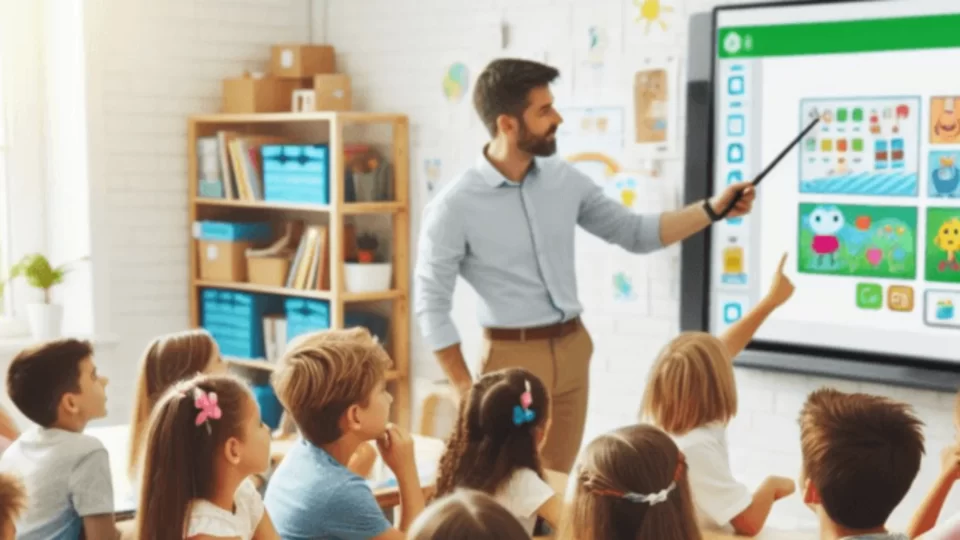In recent years, classrooms have seen a significant change. Traditional chalkboards are giving way to modern technology. One of the most exciting developments is the introduction of interactive flat panels. These high-tech boards are transforming the way students learn and engage in the classroom.
What are Interactive Flat Panels?

Interactive flat panels or smart boards are large, touch-sensitive screens. They look like big TVs but do much more. Teachers can write on them, show videos, and even access the internet. They are like a smartboard, computer, and projector all in one. These panels are easy to use and help make learning more interesting.
Why Are Schools Adopting Interactive Flat Panels?

Schools across the globe are adopting interactive flat panels in classrooms for many reasons. The primary reason is to improve student engagement. When students find lessons interesting, they pay more attention and learn better.
Interactive flat panels in classrooms make lessons more interactive. Students can see videos, play educational games, and take part in activities on the screen. This active involvement helps them understand concepts better.
Another reason schools are choosing interactive flat panels is to make learning more visual. Many students learn better when they can see what they are learning.
For example, a history lesson about ancient times becomes more engaging when students can see pictures, maps, and timelines on the screen. Similarly, science lessons become easier to understand with diagrams and videos that explain complex ideas and topics.
Read More: Get Interactive Flat Panel For Classrooms: Boost Engagement and Performance
How Interactive Flat Panels Improve Learning Outcomes

Interactive flat panels in classrooms improve learning outcomes by making lessons more engaging and interactive. When students are engaged, they participate more in class. They ask questions, join discussions, and think critically. This active participation leads to a deeper understanding of the subject.
Interactive flat panels also support different learning styles. Some students learn best by listening, while others learn by seeing or doing. Interactive flat panels cater to all these learning styles.
Teachers can use videos, images, and interactive activities to teach the same lesson in different ways. This flexibility helps all students, regardless of their learning style, to grasp and understand the material better.
Additionally, interactive flat panels in classrooms provide instant access to online resources. Teachers can quickly pull up information, videos, and images from the internet to enhance their lessons. This instant access to information helps students stay updated with the latest knowledge of their subject.
Challenges and Solutions

While interactive flat panels in classrooms offer many benefits, there are also challenges. One of the main challenges is the cost. Interactive flat panels are expensive, and not all schools can afford them. However, as technology becomes more common, prices are likely to decrease. Some schools are also finding creative ways to fund these panels, such as through government grants, donations, and partnerships with tech companies.
Another challenge is the need for training. Teachers need to learn how to use interactive flat panels effectively. Without proper training, the panels may not be used to their full potential. Many schools are addressing this issue by providing training sessions for their teachers. Once teachers become comfortable with the technology, they can use it to enhance their teaching.
Read More: How To Choose The Best Interactive Flat Panel For Classroom?
The Future of Interactive Flat Panels in Classrooms
The rise of interactive flat panels in classrooms is just the beginning. As more schools adopt this technology, the way students learn will continue to evolve.
Interactive flat panels in classrooms are likely to become a standard feature in classrooms across the country. They have the potential to bridge the gap between urban and rural education by providing equal access to high-quality learning resources.
In the future, we may see more advanced features in interactive flat panels, such as artificial intelligence (AI) and virtual reality (VR). These technologies could make learning even more personalized and immersive.
AI could help teachers identify students’ strengths and weaknesses and can make lessons accordingly. VR could transport students to different parts of the world or even back in time, making learning more engaging and memorable.
Conclusion
The rise of interactive flat panels in classrooms marks a significant shift in education. These panels are helping to make lessons more engaging, interactive, and effective. As more schools adopt this technology, students worldwide will benefit from improved learning outcomes.
The future of education looks bright, with interactive flat panels playing a key role in shaping the next generation of learners.
For more information, Call 89270-89270

